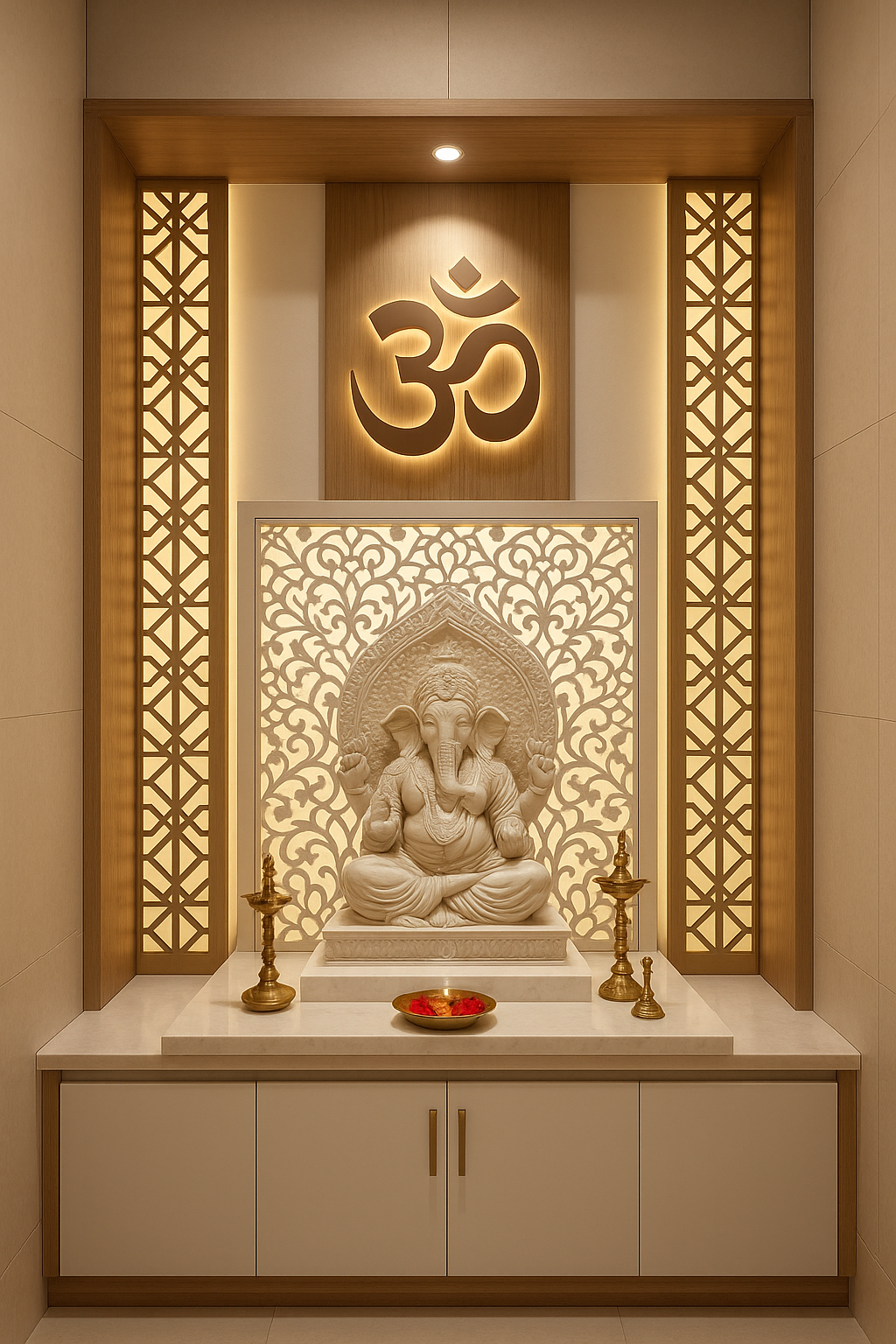Vastu-Friendly Modern Mandir Designs for Urban Living

In the heart of every Indian home lies a sacred space — the mandir — where devotion, peace, and positive energy converge. As homes evolve into compact, modern spaces, the need for a Vastu-friendly modern mandir design has become more important than ever. While the design may lean towards minimalism and modernism, the soul of the pooja room remains rooted in tradition and Vastu principles.
This blog explores how you can blend Vastu Shastra with modern aesthetics to create the perfect mandir design for home, especially in urban living scenarios. Whether you live in a high-rise apartment or a city studio, this guide will help you build a mandir that brings both serenity and style.
Why Vastu Matters for a Home Temple
Vastu Shastra is an ancient Indian science of architecture that focuses on harmonizing human dwellings with the natural elements and cosmic energies. When applied correctly, Vastu for home temple can help:
- Enhance spiritual energy in the house
- Improve mental clarity and peace
- Attract prosperity and well-being
- Promote disciplined daily rituals
A Vastu-compliant mandir design doesn't just improve the energy of your home—it strengthens your connection to your spiritual self.
Ideal Direction and Placement According to Vastu
In Vastu Shastra, the direction and location of your home temple hold deep significance. Here’s a breakdown of what you need to know:
Best Direction for Mandir
- Northeast (Ishan Kona): The most auspicious direction for placing a mandir. It receives early morning sunlight, symbolizing purity and divine blessings.
- East or North: If northeast isn’t available, east and north are also favorable for placing idols.
Avoid These Directions
- South or Southwest: These directions are believed to attract negative energy and are inauspicious for religious activities.
- Below Stairs or Near Bathrooms: Avoid placing the mandir in areas with heavy foot traffic or near unclean zones.
Additional Vastu Tips
- The mandir should not be placed directly on the ground. Use a platform or a cabinet to elevate the sacred space.
- Ensure idols are not placed against the wall but have space behind them for circulation of energy.
- Avoid storing unnecessary items in the mandir cabinet—keep it clutter-free and sacred.
Modern Mandir Design Ideas That Align with Vastu
Even in small apartments or compact living areas, it’s possible to create a Vastu-compliant and visually appealing mandir space. Let’s explore how:
1. Wall-Mounted Mandir Units
Perfect for urban homes with limited floor space, wall-mounted mandirs can be installed in corners or hallway nooks, ideally in the northeast.
- Choose wooden or marble finishes for a classic touch.
- Add backlighting or soft LED strips to highlight the sacred area.
- Keep it elevated at chest level when seated, as per Vastu for home temple.
2. Pooja Cabinets with Doors
A closed mandir design for home is both practical and Vastu-friendly. Doors protect the sanctity of the space and contain spiritual energy.
- Go for sliding doors or folding panels with jali work or etchings of Om, Swastik, or lotus.
- Opt for wood, a natural and Vastu-positive material.
3. Floating Shelf Mandir
- Ideal for extremely tight spaces, floating shelves can serve as a minimalist pooja corner.
- Place it in a northeast-facing wall.
- Use brass or copper elements for lamps, diyas, and bells to enhance spiritual energy.
4. Room Divider Mandir
If you can’t dedicate a separate room, use a wooden or glass partition to create a distinct spiritual zone.
- Install the mandir along the northeast section of the room.
- Decorate with hanging diyas, bells, or small temple arches for a traditional look.
Choosing the Right Materials: Vastu and Aesthetic Harmony
Material plays a crucial role in both design and Vastu for home temple. Here’s what you should consider:
- Wood: Considered sacred and grounding. Teak, Sheesham, or Mango wood are excellent choices.
- Marble: Pure, serene, and symbolic of peace—perfect for a white-themed mandir.
- Avoid Glass & Plastic: These are non-natural materials that can disrupt spiritual energy.
When choosing a modern mandir design, opt for earthy tones, soft whites, or muted golds that reflect peace and divinity.
Lighting and Decor Tips for Vastu-Friendly Mandirs
Lighting isn't just aesthetic—it's essential. Light represents spiritual awakening and clarity.
Lighting Tips
- Use soft yellow or warm white LED lights.
- Place a diya or oil lamp on the right side of the deity.
- Avoid harsh fluorescent or colored lighting.
Decor Essentials
- Use sacred symbols like Om, Swastika, or Trishul in your décor.
- Keep the temple space clutter-free. Only pooja items should be stored here.
- You can add fresh flowers, incense sticks, and small brass bells for authenticity.
Mistakes to Avoid in Urban Mandir Designs
Modern living comes with limitations, but avoiding these mistakes ensures your mandir stays Vastu-compliant:
- Don’t place the mandir directly against a shared bathroom wall.
- Avoid multi-purpose use of the temple area (like using it as a study or storage space).
- Never position idols facing each other or directly against a wall.
- Refrain from placing broken or chipped idols in your temple.
Buying the Perfect Mandir Online for Urban Homes
Thanks to online platforms, you can now find elegant, ready-to-install mandir designs for home that align with Vastu. Look for:
- Vastu-optimized designs labeled as northeast-friendly or temple units with adjustable shelves and storage.
- Compact mandirs with foldable doors, lighting, and customizable back panels.
- Wood or marble-based units for both visual and energetic appeal.
Popular platforms like Pepperfry, Amazon, Urban Ladder, and Craftatoz offer a wide range of Vastu-compliant mandir designs for urban dwellers.
Conclusion: Modern Meets Sacred
A well-designed modern mandir that follows Vastu for home temple can be the spiritual heart of any urban residence. While the design may be sleek and minimalist, the values it upholds are deeply rooted in tradition. By following Vastu principles, choosing the right materials, and incorporating modern aesthetics, you can create a space that’s both calming and divine.
In a world where space is limited but aspirations are limitless, let your mandir design for home reflect the peace, power, and positivity you seek in your daily life.
Note: IndiBlogHub features both user-submitted and editorial content. We do not verify third-party contributions. Read our Disclaimer and Privacy Policyfor details.







